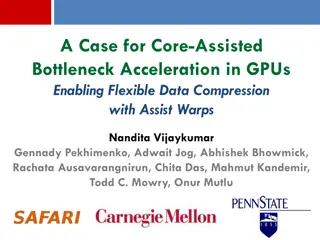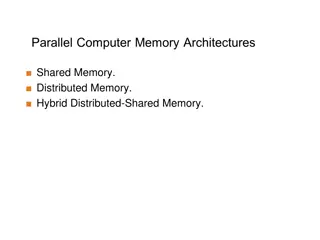Optimizing Memory Usage on GPUs Through a Marie Kondo Approach
Learn how to apply Marie Kondo's "spark joy" rule to optimize memory on GPUs by evaluating the necessity of data reads, reducing memory usage, and encoding images efficiently. Explore challenges and examples in memory optimization on the GPU for better performance.
Download Presentation

Please find below an Image/Link to download the presentation.
The content on the website is provided AS IS for your information and personal use only. It may not be sold, licensed, or shared on other websites without obtaining consent from the author.If you encounter any issues during the download, it is possible that the publisher has removed the file from their server.
You are allowed to download the files provided on this website for personal or commercial use, subject to the condition that they are used lawfully. All files are the property of their respective owners.
The content on the website is provided AS IS for your information and personal use only. It may not be sold, licensed, or shared on other websites without obtaining consent from the author.
E N D
Presentation Transcript
FROM BITSTREAMS TO BUNNIES: HOW TO GO MARIE KONDO ON THE VRAM BY BAKTASH ABDOLLAH-SHAMSHIR-SAZ
THE MOST IMPORTANT RULE Marie Kondo is well known for this most simple rule: does it spark joy? This actually applies to memory optimization on the GPU. How to read this if you re designing data streams: Do you need this (bit) to achieve the desired effect (joy)? Or could this be inferred from the surrounding environment? Memory reads are expensive. So let s only keep things that spark joy. We can infer the rest.
CHALLENGE #1 ShaderToy is a great platform for visualizing analytical expressions (implicit surfaces, analytical bilinear patches etc.) https://www.shadertoy.com/view/3tjczm by Inigo Quilez https://www.shadertoy.com/view/Xds3 zN by Inigo Quilez
CHALLENGE #1 However, you cannot bring in external images You re limited to a pre-selected group of images
CHALLENGE #1 If you try to bring in contraband data via large arrays: Generally, you should be able to go as large as 4096 array elements. However, some compilers specifically nVidia OpenGL backends for ANGLE on Linux/Android/macOS will explode as they erroneously allot 4x the amount of memory/registers necessary for accessing said data. Thus, reducing your cross-platform capacity to 1024 array elements.
EXAMPLE #1 Say we want to encode the following RGBA8 image: Do we need all 32 bits to represents this? Could we just keep RGB8 and color key the rest with black? Could we go further and crunch down RGB8 to R2G4B2 and spend 1 byte per pixel along with the color key? Yes and yes! And the color representation won t be nearly as bad as it will be uniformly applied
EXAMPLE #1 (We get the image we want in- shader working for all platforms!) https://www.shadertoy.com/view/ tltGWf (By yours truly) Necessary util (will not exist everywhere):
EXAMPLE #1 How to use? Read entire unsigned int containing the byte we re interested in Expand the byte into 3 component color
EXAMPLE #2 Replicating old school Angels cracktro (Shadow of the Beast II on the Amiga)
EXAMPLE #2 If we quantize the colors to R2G4B2 we lose the fidelity on the grayscale metallic texture Can we keep that and make an exception about the blue? Thus staying in 1Bpp and maintain fidelity?
EXAMPLE #2 Encode 1Bpp grayscale but keep the blue part a constant low luminance Luminance scaled x4
EXAMPLE #2 If we check center luminance and it s the (low) magic number and all neighbors also have the magic number we can infer that it s blue!
EXAMPLE #2 https://www.shadertoy.c om/view/WljSR1 (By yours truly) We have sparked joy! (by inferring from circumstantial information)
EXAMPLE #3 Can we replicate the Psygnosis owl? (R.I.P Ian Hetherington)
EXAMPLE #3 Our options: In-shader SVG renderer: Will be slow Will use a lot of floats and registers Leverage what we have: 1 Byte per pixel Is this really necessary? Can we do better? The owl can be just a black and white stencil:
EXAMPLE #3 We can do literally 1 bit per pixel: And also maintain a rather high resolution
EXAMPLE #3 Apply 3x3 AA when sampling Add colors and patterns strategically And voila!
EXAMPLE #3 End result: https://www.shad ertoy.com/view/3l BSzK (By yours truly) Homage to this scene from Shadow of the Beast I
EXAMPLE #3 Stencil decode is much simpler Just 1 bit we re interested in Image reconstruction is much more involved:
CHALLENGE #2 What about geometry? Example: The Stanford bunny Used by Sebastien Hillaire to demonstrate improved delta- tracking integral (https://www.shadertoy.com/view/MdlyDs) Coarse around the ears: Can we do better?
CHALLENGE #2 Yes, we can! Encode entire geometry as a Sparse Voxel Octree Waste no bits on empty top and mid-level bricks You can trace this, live! We packed the bunny and had room for 2 more! https://www.shadertoy.com /view/dlBGRc (By yours truly)
CHALLENGE #2 For this we actually need a bitstream reader:
CHALLENGE #2 Live trace via hole-skipping ray-box (slab) intersection tests:
CHALLENGE #2 Read octree nodes only if they re occupied (i.e. encountered a set bit). Otherwise, skip the size of the level you re at (top or mid- level brick):
CHALLENGE #2 Does this work at scale? Turns out: no (lol!) First attempt by yours truly to combine with SDFs Too slow Pros: Smooth corners Cons: Too many reads (3x3x3 fetches to construct a local rounded box SDF) All value in hole-skipping gone
CHALLENGE #2 Code available on Shadertoy-utils (by yours truly): https://github.com/toomuchvoltage/shadertoy-utils Below code executed 3x3x3 times! (Oof )
CHALLENGE #2 Second attempt: Encode the entire bunny as a distance field Three step approach: 1. Expand SVO into tiles in a sub-region of a floating point target 2. Generate distance field via JFA Keep going until offsetPower is -1.0 3. Compact SDF output to use as little memory as possible 40x40x40 bunny only needs a (40, 40*3) RGBA32F sub-image
CHALLENGE #2 Bingo! Even runs on my phone: S22 Ultra https://www.shadertoy.com/vie w/cs3GRH (By yours truly)
CHALLENGE #2 Honorable mention: RLE encoded Stanford dragon by Anton Schreiner https://www.shadertoy. com/view/tlSSWD There is no option to live-trace here though! (would be too slow) Expanded version would not hole-skip either.
CHALLENGE #2 Have we seen this sort of runtime expansion before? Yes: .kkrieger by .theprodukkt Entire video game in <100KB All geometry is CSG All textures are encoded as successive brush strokes Expanded into VRAM at runtime
CHALLENGE #2 NOTE: if you want to ship materials with the bunny, encode as swatch bits following the leaf brick bits We can access them as we encounter intersections Another rule by Marie Kondo: Store items based on frequency of use! In GPU optimization this is spatial locality for spatially coherent access Results in less cache thrashing
CHALLENGE #3 What about games? Can this help our title? Yes! Encode instance properties in your instance property buffers (UAVs/SSBOs) as bits in a bitfield
CHALLENGE #3 Decode inside shader
CHALLENGE #3 What else? We can pack and unpack data into vertices so as to push more geometry We can store normal as sign of Z, X and Y and infer via sqrt
CHALLENGE #3 Try hard enough and you should hit 16 bytes per vertex! ;) https://twitter.co m/SebAaltonen/s tatus/1515735247 928930311
CHALLENGE #3 Vertex positions in Ryse: Son of Rome were compressed to represent a fraction of the mesh AABB: Presentation missing from the web But instructions on how to do this in CryEngine is available here: https://docs.cryengine.com/display/CEMANUAL/Geom+Cac he+Technical+Overview Entire tangent space was also encoded as a quaternion with some additional info. See q-tangent: https://dl.acm.org/doi/abs/10.1145/2037826.2037841
CHALLENGE #3 Even more compact tangent space representation: https://www.jeremyong.com/graphics/2023/01/09/tangent- spaces-and-diamond-encoding/
CHALLENGE #3 This is efficient in path-tracing too! Ylitie2017 not only encodes vertex positions as fractions of leaf AABBs, but makes internal node AABBs fractions of each other: https://research.nv idia.com/sites/def ault/files/publicati ons/ylitie2017hpg- paper.pdf
CHALLENGE #3 Every leaf node in Teardown uses an 8-bit index to look into a color palette: Full tech talk here: https://www.youtube.com/watch?v=0VzE8ROwC58 Many many ways to spark joy!
CHALLENGE #3 Even the hardware does this for you! BC1-7 block compression is all about storing color endpoints and flattening colors as 1Bpp fractions on the line that forms https://www.reedbeta.com/blog/understanding- bcn-texture-compression-formats/
THAT IS ALL! Thank you for listening! Feel free to reach out: baktash@toomuchvoltage.com @toomuchvoltage























